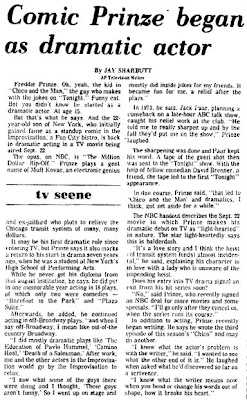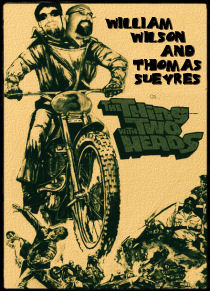Oh crap, it's over a week into the new month and I'm already slackin'! I'll follow Will's less-is-more lead and give you four meatier reviews. Didn't we start out with ten? Next month we should be down to two.
THE STRANGER ON THE THIRD FLOOR (1940): An ambitious investigative journalist, Mike Ward (John McGuire), helps send a down-on-his-luck drifter (Elisha Cook Jr) to the chair for the murder of a diner owner. Never mind that there isn't a shred of evidence and never mind that Ward is furthering his career by writing up the story in unobjective prose. Gradually Ward starts suspecting that he sent an innocent man to the chair and a stranger with a white scarf (Peter Lorre) is the actual killer. Often cited as the first film-noir, this low-rent B title was shot on the quick by RKO, due to the fact that they had Lorre on contract for another two days (stories like that just warm the cockles of my cynical heart). Clearly writer Frank Partos (who was nominated for an Oscar for the 1951 thriller HOUSE ON TELEGRAPH HILL) was aiming for a scathing condemnation of shoddy, unethical journalism and an unreliable justice system. Some of it works, some of it doesn't and most of its faults are due to the quickie production. Writer-turned-director Boris Ingster goes hog-wild with surrealist and expressionist influences during the impressive nightmare sequence, but McGuire's over-the-top scenery-chewing in every single scene really lets this one down. Worth seeing for noir and Lorre fans, but there is a reason this has been hard to get a hold of for so many decades.
TERMINATOR WOMAN (1993): Picture it. Videostore. 1990s. Jean-Claude Van Damme as far as the eye can see. Oh hey, there's a mess of Billy Blanks movies and Cynthia Rothrock for days... Yep, it's all about kickboxing flicks. Be it cyborgs (thank you Albert), secret tournaments, or a cop whose deadly weapons are not just his hands, but his feet too, you get some sort of martial arts that, right or wrong, was usually packaged as kickboxing. Karen Sheperd (not to be confused with Congresswoman Karen Shepherd) has always had a place in our martial arts shrine due to her amazing karate skills that were put to good use in great movies such as the Yuen Biao, Cynthia Rothrock classic ABOVE THE LAW (1986). Why she never broke out like Rothrock is a mystery. Amazing fighting skills plus knock-out looks? That should have translated to a series of ever-worsening DTV action flicks. Baffling, right? I think maybe this movie solves the mystery.
Two cops with a love/hate history that dates back to Jay (Jerry Trimble) having his pride handed to him by Julie (Karen Shepard) in a karate match (don't all great relationships start that way?) are grudgingly teamed up on an assignment to escort a drug-ring witness back to South Africa to pin-point a cache of gold.
En route, our two karate kops are attacked by the drug lord Alex (Michel Qissi). Alex manages to easily kidnap Julie (what does that say about Jay?), while trying to grab the witness and the gold for himself. Michel Qissi got his start in the filmworld by being Van Damme's training buddy from the old country. After working on Van Damme's movies, he finally has a chance to direct and co-star in his very own rock-bottom actioner. Too bad he doesn't have a freakin' clue how to direct a fight scene, because we didn't show up for the dialogue. Well, yeah, actually we kinda did do that, but hilarious dialogue is worthless without a good, four-limbed butt-whuppin'. It isn't so much that there are not enough action scenes, it's that they are really short, two punch affairs that are heavily edited to imply the fight instead of showing it to you. Instead of the intense choreography and wide shots of an old Jackie Chan or Corey Yuen, we get the choppy patchwork of a Jason Statham movie. No shakey-cam, though. Points in Qissi's favor there. Trimble gets a chance to shine, well, glimmer, maybe, but Karen Sheperd is sadly wasted here, though her under-cover uniform includes a black-spangly busier that is nothing short of arresting... Yeah, yeah, stop groaning.
HUMONGOUS (1982): Seems like this off-shoot of the backwoods/deformed killer subgenre struck a chord in a lot of people, not just me, as it has developed a bit of a following over the past few years. Opening with a surprisingly brutal sequence (particularly in its uncut form) in which a party on a remote island is disrupted when a drunken rape turns into a bloodbath when the victims dogs attack the rapist and literally tear him to shreds. Flash forward 40 years and a group of teens (of course!) are taking a boating trip that would take them past the site of the rape, the legendary Dog Island. After rescuing a man lost at sea (who delivers the obligatory warning), they run aground in the shallow reefs and are forced to investigate the creepy island and learn its dark secret. Back in the day this movie scared the livin' crap out of me, and it seems I was not alone on this one. Unlike so many of the similar films that would follow, it didn't have ethnically diverse teens who are all fun-lovin' kids desperately trying to connect with it's audience in a way that only people who are completely out of touch try to be. These kids have some serious issues and there is no token black guy to provide embarrassing comic relief. Director Paul Lynch (who had some success with a little film called PROM NIGHT in 1980) actually makes the most of his meager budget to provide a creepy atmosphere of isolation with minimal music and foley work. The characters mention that the island is too quiet, and it is. No chirping birds or sounds of life. Saves money and adds atmosphere! The ending sequences that take place in almost total darkness are very effective with snatches of light showing you just what you need to see to allow the creature to seem more horrifying than it no doubt would fully lit as today's test audiences would demand. It may not be quite as terrifying as it was back in the day, but there's a lot to like about this creepy little bastard.
 DANGEROUS COPS (1987): The Japanese get a cut of the cheeseball '80s cop-comedy with this slick and incomprehensibly Japanese outing that even with subtitles, I can't figure out if it's a subversive satire or to be taken at face value as a "straight" action-comedy.
DANGEROUS COPS (1987): The Japanese get a cut of the cheeseball '80s cop-comedy with this slick and incomprehensibly Japanese outing that even with subtitles, I can't figure out if it's a subversive satire or to be taken at face value as a "straight" action-comedy.
There are those that like to see homoerotic metaphors around every corner (someone once made the claim that the tag-line for John Carpenter's THE THING was homoerotic). I guess in some ways the buddy/cop movies of the '80s are easy targets for that sort of this sort of thought and it was up to the Japanese to take it one step further.
The first feature film based on an incredibly popular TV show, we have two, sharp-dressing, loose-cannon cops, Taka-yama (Hiroshi Tachi) and Oshita (Kyôhei Shibata), who have no luck with the ladies or the bad guys or their hot-tempered chief. After tearing up the city on a wild car chase, they find themselves investigating the murder of a scientist at a cancer-research lab. Apparently someone has stolen their research and now our cops must track down the villain. But they sure aren't going to make it easy on themselves.
It doesn't take very long to get a lead and after another chase, the duo is confronted with a hostage situation and end up returning to the police station handcuffed together. This is where thing get weird. Instead of walking into the station, they tango into the station, complete with a rose in teeth and... a big dip complete with a big kiss. Ummmm... what the fuck am I watching? After this debacle they are quickly bounced around on various demeaning assignments, such as "masher" detail in which they must hang out in public restrooms, and yes before you ask, this includes a scene with a shocked and outraged matronly woman. Yep, that man-in-a-woman's-bathroom gag translates into any language. One bit involves them being on "hobo" detail, in which Oshita dresses up as a rastafari "hobo" and carries around a boombox. Nothing is funnier than being homeless! All the while they continue to try and chase down leads on the big case. Yeah, yeah, I hear you saying "what about all that homo stuff you were talking about?" Ok fine, when Taka is all depressed because the villain isn't falling for their plan, Oshita puts on a little one-man, song and dance number on a stage just for him. No, really. During a tense moment Taka is seen stroking the bowed head of the young rookie officer. Plus there is tons of other bits here and there that are just things that straight men would not do. Errr... not that there's anything wrong with that!
To be fair there are some fun moments in the film and some of the throwaway jokes are actually pretty funny. There's moments such as when Oshita, in his bright, black and yellow patterned shirt goes to a high-class bar in which the dress-code requires a tie. He is given a loaner, which is a red tie, and the pregnant pause and look on his face before pointing out that the tie would clash with his shirt is well played. So is the bit where Oshita goes to buy groceries for the safehouse where they are holding an accessory to the crime and ensures that he picks out the perfect white wine for dinner. Funny, but, hmmmmm... See what I mean?
The movie moves at a breakneck pace trying to cram in an entire season's worth of gags, action and pointless sub-plots in addition to laying on the '80s kistch with a trowel. While some stuff doesn't translate at all (a Japanese character printed on a fan is changed to a presumably bad word with a single piece of tape), director Yasuharu Hasebe throws enough stuff at the wall to ensure that something sticks and does it with oodles of hyper-stylized '80s sensibility.
THE STRANGER ON THE THIRD FLOOR (1940): An ambitious investigative journalist, Mike Ward (John McGuire), helps send a down-on-his-luck drifter (Elisha Cook Jr) to the chair for the murder of a diner owner. Never mind that there isn't a shred of evidence and never mind that Ward is furthering his career by writing up the story in unobjective prose. Gradually Ward starts suspecting that he sent an innocent man to the chair and a stranger with a white scarf (Peter Lorre) is the actual killer. Often cited as the first film-noir, this low-rent B title was shot on the quick by RKO, due to the fact that they had Lorre on contract for another two days (stories like that just warm the cockles of my cynical heart). Clearly writer Frank Partos (who was nominated for an Oscar for the 1951 thriller HOUSE ON TELEGRAPH HILL) was aiming for a scathing condemnation of shoddy, unethical journalism and an unreliable justice system. Some of it works, some of it doesn't and most of its faults are due to the quickie production. Writer-turned-director Boris Ingster goes hog-wild with surrealist and expressionist influences during the impressive nightmare sequence, but McGuire's over-the-top scenery-chewing in every single scene really lets this one down. Worth seeing for noir and Lorre fans, but there is a reason this has been hard to get a hold of for so many decades.
TERMINATOR WOMAN (1993): Picture it. Videostore. 1990s. Jean-Claude Van Damme as far as the eye can see. Oh hey, there's a mess of Billy Blanks movies and Cynthia Rothrock for days... Yep, it's all about kickboxing flicks. Be it cyborgs (thank you Albert), secret tournaments, or a cop whose deadly weapons are not just his hands, but his feet too, you get some sort of martial arts that, right or wrong, was usually packaged as kickboxing. Karen Sheperd (not to be confused with Congresswoman Karen Shepherd) has always had a place in our martial arts shrine due to her amazing karate skills that were put to good use in great movies such as the Yuen Biao, Cynthia Rothrock classic ABOVE THE LAW (1986). Why she never broke out like Rothrock is a mystery. Amazing fighting skills plus knock-out looks? That should have translated to a series of ever-worsening DTV action flicks. Baffling, right? I think maybe this movie solves the mystery.
Two cops with a love/hate history that dates back to Jay (Jerry Trimble) having his pride handed to him by Julie (Karen Shepard) in a karate match (don't all great relationships start that way?) are grudgingly teamed up on an assignment to escort a drug-ring witness back to South Africa to pin-point a cache of gold.
 |
| Qissi's idea of showcasing Karen's killer kicks |
HUMONGOUS (1982): Seems like this off-shoot of the backwoods/deformed killer subgenre struck a chord in a lot of people, not just me, as it has developed a bit of a following over the past few years. Opening with a surprisingly brutal sequence (particularly in its uncut form) in which a party on a remote island is disrupted when a drunken rape turns into a bloodbath when the victims dogs attack the rapist and literally tear him to shreds. Flash forward 40 years and a group of teens (of course!) are taking a boating trip that would take them past the site of the rape, the legendary Dog Island. After rescuing a man lost at sea (who delivers the obligatory warning), they run aground in the shallow reefs and are forced to investigate the creepy island and learn its dark secret. Back in the day this movie scared the livin' crap out of me, and it seems I was not alone on this one. Unlike so many of the similar films that would follow, it didn't have ethnically diverse teens who are all fun-lovin' kids desperately trying to connect with it's audience in a way that only people who are completely out of touch try to be. These kids have some serious issues and there is no token black guy to provide embarrassing comic relief. Director Paul Lynch (who had some success with a little film called PROM NIGHT in 1980) actually makes the most of his meager budget to provide a creepy atmosphere of isolation with minimal music and foley work. The characters mention that the island is too quiet, and it is. No chirping birds or sounds of life. Saves money and adds atmosphere! The ending sequences that take place in almost total darkness are very effective with snatches of light showing you just what you need to see to allow the creature to seem more horrifying than it no doubt would fully lit as today's test audiences would demand. It may not be quite as terrifying as it was back in the day, but there's a lot to like about this creepy little bastard.
 DANGEROUS COPS (1987): The Japanese get a cut of the cheeseball '80s cop-comedy with this slick and incomprehensibly Japanese outing that even with subtitles, I can't figure out if it's a subversive satire or to be taken at face value as a "straight" action-comedy.
DANGEROUS COPS (1987): The Japanese get a cut of the cheeseball '80s cop-comedy with this slick and incomprehensibly Japanese outing that even with subtitles, I can't figure out if it's a subversive satire or to be taken at face value as a "straight" action-comedy.There are those that like to see homoerotic metaphors around every corner (someone once made the claim that the tag-line for John Carpenter's THE THING was homoerotic). I guess in some ways the buddy/cop movies of the '80s are easy targets for that sort of this sort of thought and it was up to the Japanese to take it one step further.
The first feature film based on an incredibly popular TV show, we have two, sharp-dressing, loose-cannon cops, Taka-yama (Hiroshi Tachi) and Oshita (Kyôhei Shibata), who have no luck with the ladies or the bad guys or their hot-tempered chief. After tearing up the city on a wild car chase, they find themselves investigating the murder of a scientist at a cancer-research lab. Apparently someone has stolen their research and now our cops must track down the villain. But they sure aren't going to make it easy on themselves.
 |
| Nobody does blackface like the Asians |
 |
| I wonder who helped finance the film? |
To be fair there are some fun moments in the film and some of the throwaway jokes are actually pretty funny. There's moments such as when Oshita, in his bright, black and yellow patterned shirt goes to a high-class bar in which the dress-code requires a tie. He is given a loaner, which is a red tie, and the pregnant pause and look on his face before pointing out that the tie would clash with his shirt is well played. So is the bit where Oshita goes to buy groceries for the safehouse where they are holding an accessory to the crime and ensures that he picks out the perfect white wine for dinner. Funny, but, hmmmmm... See what I mean?
The movie moves at a breakneck pace trying to cram in an entire season's worth of gags, action and pointless sub-plots in addition to laying on the '80s kistch with a trowel. While some stuff doesn't translate at all (a Japanese character printed on a fan is changed to a presumably bad word with a single piece of tape), director Yasuharu Hasebe throws enough stuff at the wall to ensure that something sticks and does it with oodles of hyper-stylized '80s sensibility.




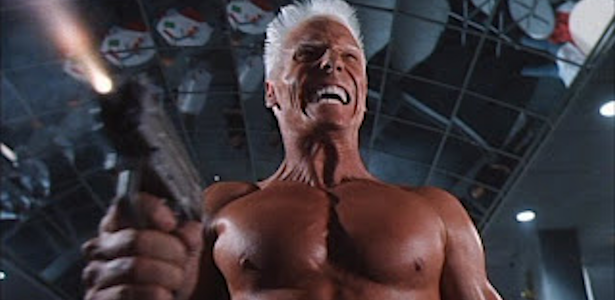
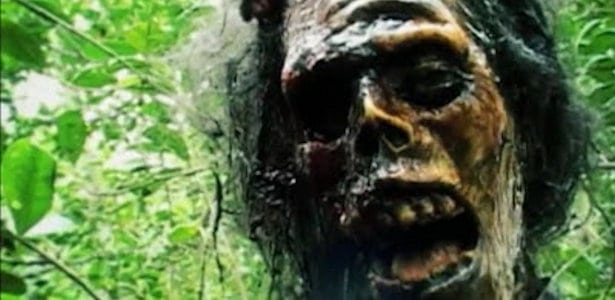
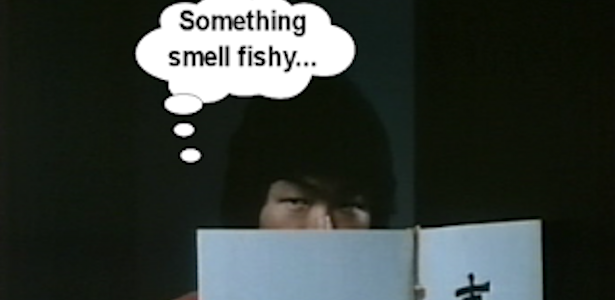
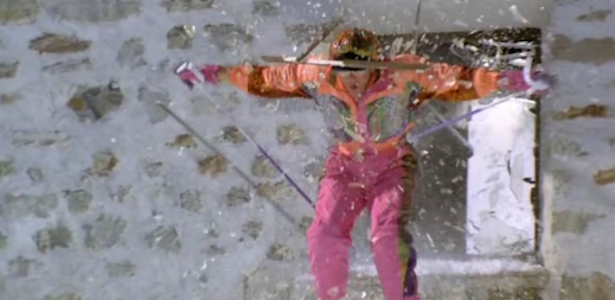
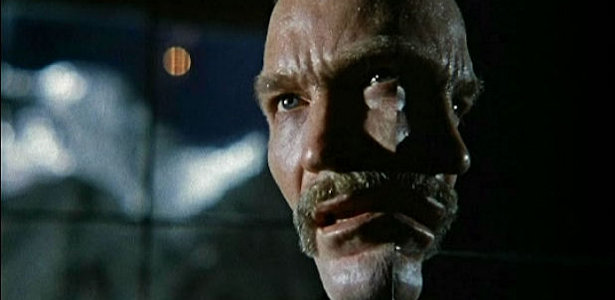



.jpg)










































